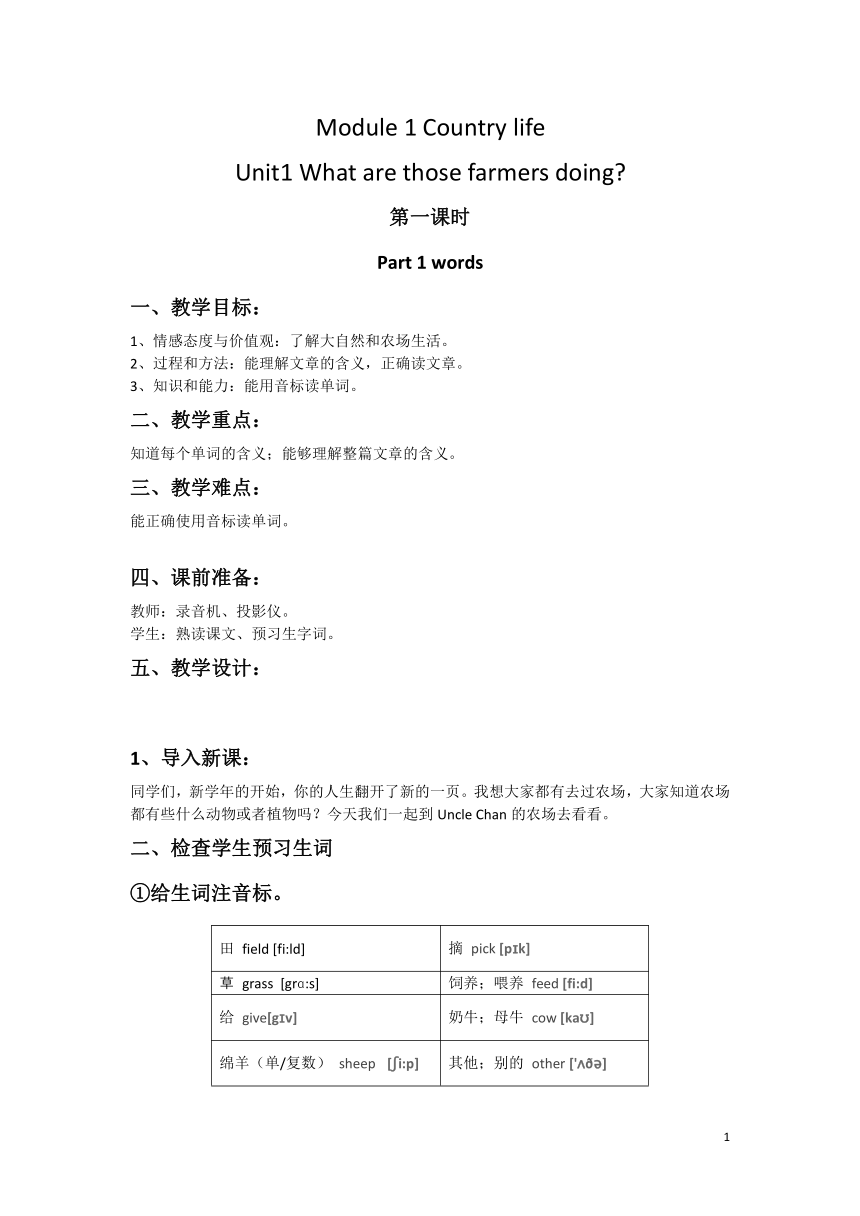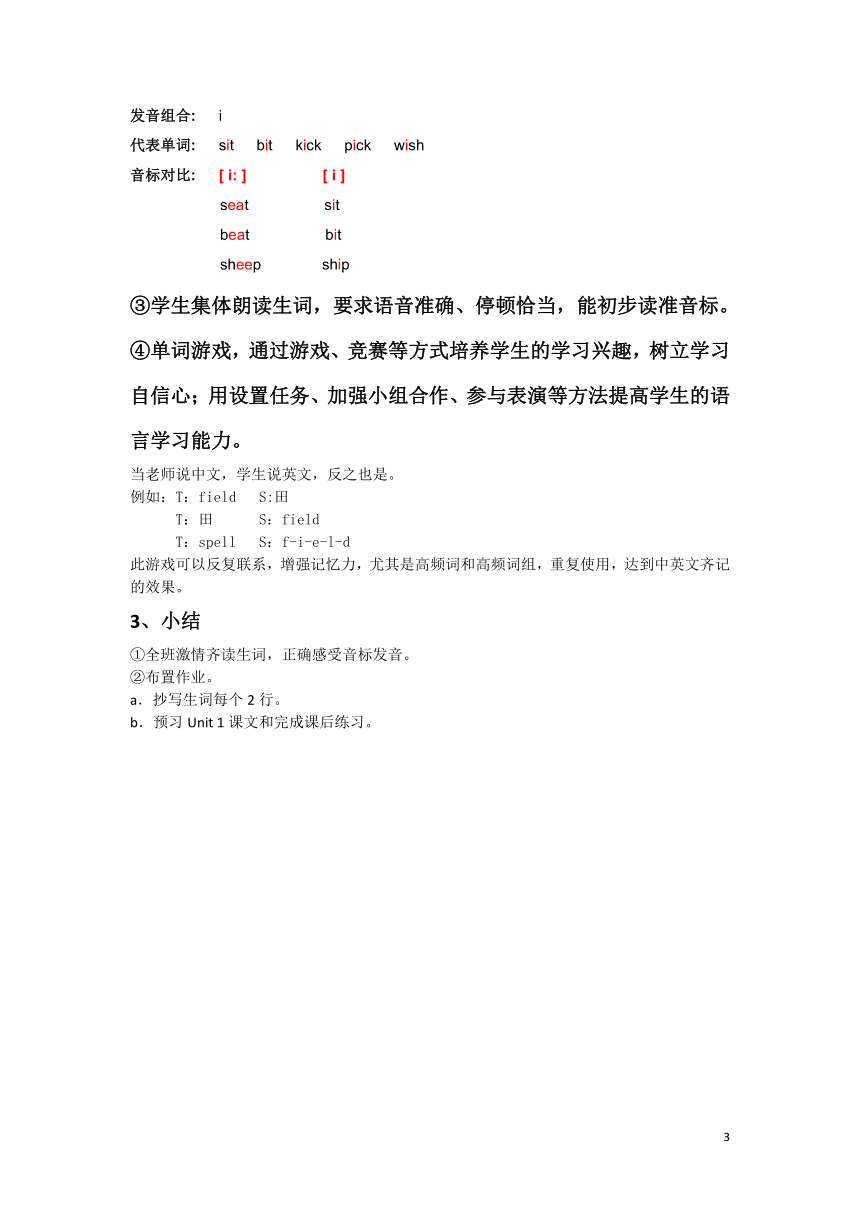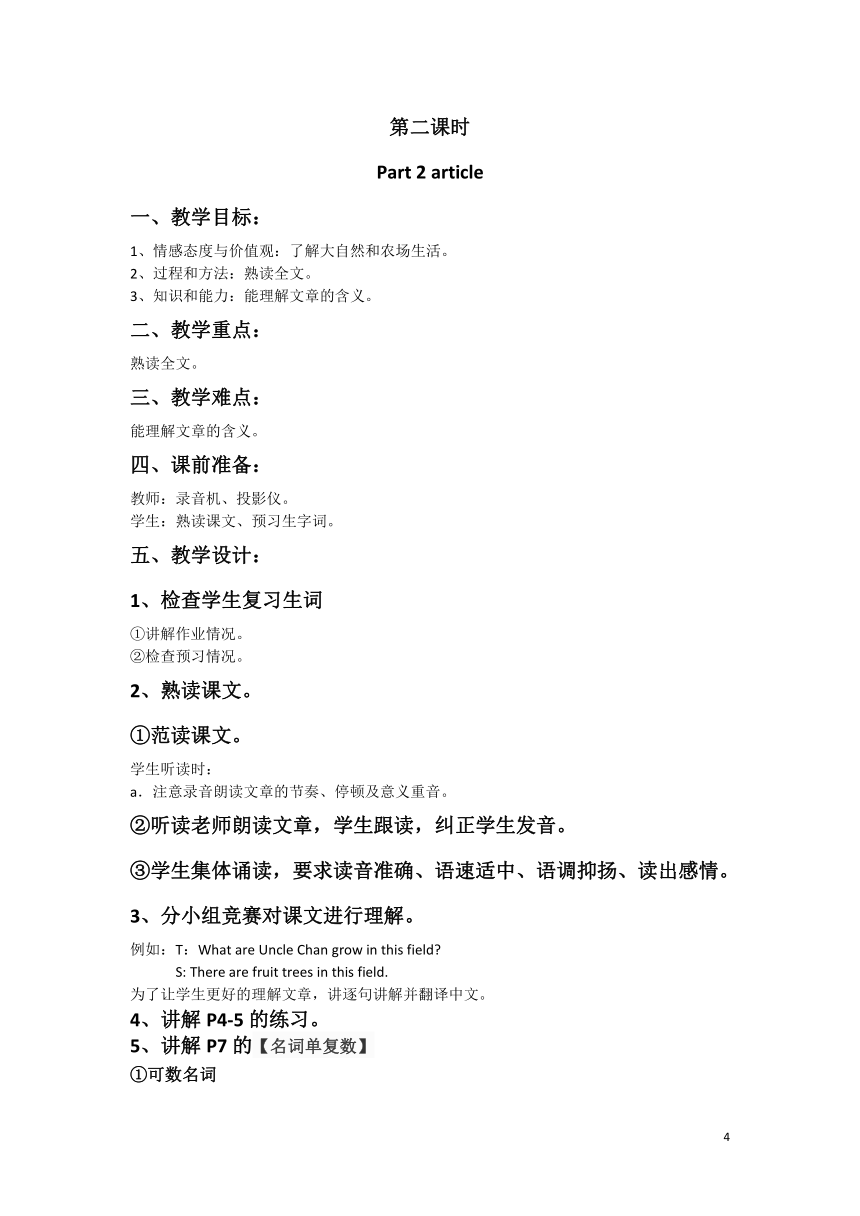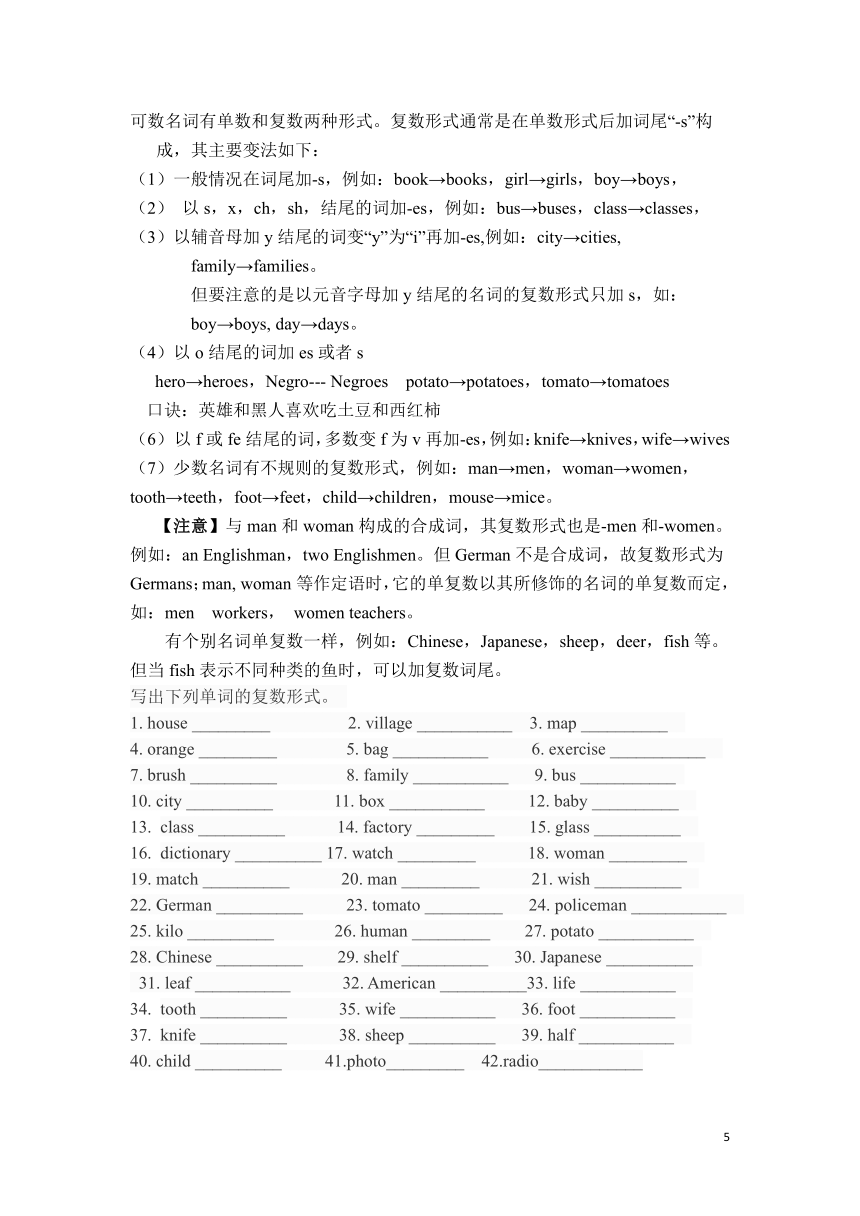Unit 1 What are those farmers doing? 学案(无答案)
文档属性
| 名称 | Unit 1 What are those farmers doing? 学案(无答案) |

|
|
| 格式 | zip | ||
| 文件大小 | 24.8KB | ||
| 资源类型 | 教案 | ||
| 版本资源 | 教科版(广州) | ||
| 科目 | 英语 | ||
| 更新时间 | 2018-07-13 12:30:46 | ||
图片预览





文档简介
Module 1 Country life
Unit1 What are those farmers doing?
第一课时
Part 1 words
一、教学目标:
1、情感态度与价值观:了解大自然和农场生活。
2、过程和方法:能理解文章的含义,正确读文章。
3、知识和能力:能用音标读单词。
二、教学重点:
知道每个单词的含义;能够理解整篇文章的含义。
三、教学难点:
能正确使用音标读单词。
四、课前准备:
教师:录音机、投影仪。
学生:熟读课文、预习生字词。
五、教学设计:
1、导入新课:
同学们,新学年的开始,你的人生翻开了新的一页。我想大家都有去过农场,大家知道农场都有些什么动物或者植物吗?今天我们一起到Uncle Chan的农场去看看。
二、检查学生预习生词
①给生词注音标。
田 field?[fi:ld]
摘 pick [p?k]
草 grass??[grɑ:s]
饲养;喂养 feed [fi:d]
给 give[g?v]
奶牛;母牛 cow [ka?]
绵羊(单/复数) sheep? [?i:p]
其他;别的 other ['?e?]
几(个、条、……)a few
山羊 goat? [g??t]
鹅(单/复数) goose [gu?s] /geese[ɡi?s]
河;江 river ['riv?]
2、分小组练习单词记忆游戏。
①范读课文。
学生听读时:
a.注意老师朗读生词的节奏、停顿及意义重音。
②听读老师朗读生词,学生跟读,穿插讲解本单元中经常出现的音标【i】和【i:】。
[ i: ]
音标特征: 前元音 舌位高 不圆唇 长元音
发音要诀: 舌前部抬得最高,牙齿近乎全合。舌尖抵下齿。
舌前部向硬颚尽量抬起,但比汉语普通话 “i”音稍低, 没有摩擦。
嘴唇向两旁伸开,成扁平行. 做微笑状,发[ i: ]长音。
注意:“:”是长音符号,长元音往往比它相应的短元音长两倍以上。
发音组合: e ee ea ie ei
代表单词: me he we even
bee feel breeze deep free
seat beat lead tea eat reason
grief believe achieve
receive conceive
[ i ]
音标特征: 前元音 半高音 扁平唇 短元音
发音要诀: 舌前部比[i:]稍低,比[e]高,舌尖抵下齿,嘴唇扁平分开。
牙床也开得稍大一些比[ i:]稍宽,比[ e ]窄。
上下齿之间的距离大约可以容纳一个小指尖。
使下颚稍稍下垂,舌前部也随之稍稍下降,即可发出短促[ i ]音。
发音组合: i
代表单词: sit bit kick pick wish
音标对比: [ i: ] [ i ]
seat sit
beat bit
sheep ship
③学生集体朗读生词,要求语音准确、停顿恰当,能初步读准音标。
④单词游戏,通过游戏、竞赛等方式培养学生的学习兴趣,树立学习自信心;用设置任务、加强小组合作、参与表演等方法提高学生的语言学习能力。
当老师说中文,学生说英文,反之也是。
例如:T:field S:田
T:田 S:field
T:spell S:f-i-e-l-d
此游戏可以反复联系,增强记忆力,尤其是高频词和高频词组,重复使用,达到中英文齐记的效果。
3、小结
①全班激情齐读生词,正确感受音标发音。
②布置作业。
a.抄写生词每个2行。
b.预习Unit 1课文和完成课后练习。
第二课时
Part 2 article
一、教学目标:
1、情感态度与价值观:了解大自然和农场生活。
2、过程和方法:熟读全文。
3、知识和能力:能理解文章的含义。
二、教学重点:
熟读全文。
三、教学难点:
能理解文章的含义。
四、课前准备:
教师:录音机、投影仪。
学生:熟读课文、预习生字词。
五、教学设计:
1、检查学生复习生词
①讲解作业情况。
②检查预习情况。
2、熟读课文。
①范读课文。
学生听读时:
a.注意录音朗读文章的节奏、停顿及意义重音。
②听读老师朗读文章,学生跟读,纠正学生发音。
③学生集体诵读,要求读音准确、语速适中、语调抑扬、读出感情。
3、分小组竞赛对课文进行理解。
例如:T:What are Uncle Chan grow in this field?
S: There are fruit trees in this field.
为了让学生更好的理解文章,讲逐句讲解并翻译中文。
4、讲解P4-5的练习。
5、讲解P7的【名词单复数】
①可数名词
可数名词有单数和复数两种形式。复数形式通常是在单数形式后加词尾“-s”构成,其主要变法如下:
(1)一般情况在词尾加-s,例如:book→books,girl→girls,boy→boys,
(2) 以s,x,ch,sh,结尾的词加-es,例如:bus→buses,class→classes,
(3)以辅音母加y结尾的词变“y”为“i”再加-es,例如:city→cities, family→families。
但要注意的是以元音字母加y结尾的名词的复数形式只加s,如:boy→boys, day→days。
以o结尾的词加es或者s
hero→heroes,Negro--- Negroes potato→potatoes,tomato→tomatoes
口诀:英雄和黑人喜欢吃土豆和西红柿
(6) 以f或fe结尾的词,多数变f为v再加-es,例如:knife→knives,wife→wives
(7)少数名词有不规则的复数形式,例如:man→men,woman→women,tooth→teeth,foot→feet,child→children,mouse→mice。
【注意】与man和woman构成的合成词,其复数形式也是-men和-women。例如:an Englishman,two Englishmen。但German不是合成词,故复数形式为 Germans;man, woman等作定语时,它的单复数以其所修饰的名词的单复数而定,如:men workers, women teachers。
有个别名词单复数一样,例如:Chinese,Japanese,sheep,deer,fish等。但当fish表示不同种类的鱼时,可以加复数词尾。
写出下列单词的复数形式。
1. house _________ 2. village ___________ 3. map __________
4. orange _________ 5. bag ___________ 6. exercise ___________
7. brush __________ 8. family ___________ 9. bus ___________
10. city __________ 11. box ___________ 12. baby __________
class __________ 14. factory _________ 15. glass __________
dictionary __________ 17. watch _________ 18. woman _________
19. match __________ 20. man _________ 21. wish __________
22. German __________ 23. tomato _________ 24. policeman ___________
25. kilo __________ 26. human _________ 27. potato ___________
28. Chinese __________ 29. shelf __________ 30. Japanese __________
31. leaf ___________ 32. American __________33. life ___________
tooth __________ 35. wife ___________ 36. foot ___________
knife __________ 38. sheep __________ 39. half ___________
40. child __________ 41.photo_________ 42.radio____________
②不可数名词“量”的表示方法
在英语中,不可数名词如果要表示“量”的概念,可以用以下两种方法:
(1)用much, a little, a lot of/lots of, some, any等表示多少,例如:
这个富人有很多钱。______________________
瓶子里有一些水。________________________
瓶子里有水吗?_______________________
我不喜欢冬天,因为有太多的雪和冰。________________________________
(2)用a piece of 这类定语,例如:
一张纸______________ 一块木头______________
一瓶橘子汁_________________ 一瓶水________________-
一杯咖啡___________________ 一包大米_________________
三张纸______________________ 三包大米____________ ___
如果要表示“两杯茶”、“四张纸”这类概念时,在容器后加复数,例如: two cups of tea four pieces of paper three glasses of water
不可数名词也可用a lot of, lots of, some, any, much等来修饰。
注:不同国籍人的单复数? 国籍 总称(谓语用复数) 单数 复数 中国人 the?Chinese, a?Chinese, two?Chinese ?????
瑞士人 the?Swiss, a?Swiss, two?Swiss 澳大利亚人the?Australians, an?Australian two?Australians
俄国人 the?Russians, a?Russian, two?Russians 意大利人 the?Italians, an?Italian, two?Italians ??????
希腊人 the?Greek, a?Greek, two?Greeks 法国人 the?French, a?Frenchman, two?Frenchmen ??
日本人 the?Japanese, a?Japanese, two?Japanese 美国人 the?Americans, an?American, two?Americans
印度人 the?Indians, an?Indian, two?Indians 加拿大人the?Canadians, a?Canadian, two?Canadians
德国人 the?Germans, a?German, two?Germans 英国人 the?English, an?Englishman, two?Englishmen
瑞典人 the?Swedish, a?Swede, two?Swedes
③名词的所有格
名词所有格,用来表示人或物的所有,以及领属关系。
1. 表示有生命的名词的所有格其单数形式是加 's,其复数形式是s',例如:a student's room, students' rooms, father's shoes,Teacher’s Day, Father’s Day。
2. 如其结尾不是s的复数形式仍加 's,如:Children's Day。
3. 在表示时间、距离、长度、重量、价格、世界、国家等名词的所有格要用 's,例如:a twenty minutes' walk,ten miles' journey,a boat's length,two pounds' weight, ten dollars' worth。
4. 无生命名词的所有格则必须用of结构,例如:a map of China,the end of this term,the capital of our country, the color of the flowers。
5. 双重所有格,例如:a friend of my father's我爸爸的意味朋友
one of my father's friends 我爸爸的朋友之一 。
【注意】
如果两个名词并列,并且分别有 's,则表示“分别有”,例如:John's and Mary's rooms(约翰和玛丽各有一间,共两间);Tom's and Mary's bikes(两人各自的自行车)。
两个名词并列,只有一个's,则表示“共有”,例如:John and Mary's room(约翰和玛丽共有一间);Tom and Mary's mother(即Tom与Mary是兄妹)。
【实例解析】
1.These _________ have saved many children’s lives.
A. woman doctors B. women doctor C. women doctors D. woman doctor
2.This is _________ bedroom. The twin sisters like it very much.
A. Anne and Jane B. Anne’s and Jane’s
C. Anne’s and Jane D. Anne and Jane’s
3.---Are there any ________ on the farm?
---Yes, there are some.
A. horse B. duck C. chicken D. sheep
4.---What would you like to drink, ________ or orange?
---Orange, please.
A. hamburger B. chip C. tea
专项练习:单项填空
1.--- Where have you been, Tim?
--- I’ve been to ______.
A. the Henry house????? B. the Henry family
C. The Henry’s home??? D. Henry’s
2.Are they going to have a picnic on _______ ?
A. Children’s Day??? B. Childrens’s Day
C. Childrens Day????? D. Children Day
3.Where are the students? Are they in _______ ?
A. the Room 406?? B. Room 406?? C. the 406 Room?? D. 406 Room
4.--- They are thirsty. Will you please give them ______ ?
--- Certainly.
A. some bottles of waters?? B. some bottles of water
C. some bottle of water???? D. some bottle of waters
5.Mike hurt one of his ______ in the accident yesterday.
A. tooth?? B. feet?? C. hand?? D. ear
6.There is some _______ on the plate.
A. cakes?? B. meat?? C. potato?? D. pears
7.In England, the last name is the? _______ .
A. family name?? B. middle?? C. given name?? D. full name
8.The are going to fly _______ to Beijing.
A. Germen?? B. Germany?? C. Germanys?? D. Germans
9.The______ has two _______ .
A. boys; watches?? B. boy; watch?? C. boy; watches?? D. boys; watch
10.The little baby has two _______ already.
A. tooth?? B. tooths?? C. teeth?? D. teeths
11.What’s your _______ for being late again?
A. idea?? B. key?? C. excuse?? D. news
12.--- It’s dangerous here. We’d better go out quickly.
--- But I think we should let _______ go out first.
A. woman and children?? B. women and child
C. woman and child????? D. women and children
6、小结
①全班激情齐读课文,感受文章的发音。
②布置作业。
a.背诵课文。
b.背诵单词准备听写。
第三课时
Part 3 grammar
一、教学目标:
1、情感态度与价值观:了解文章的语法点。
2、过程和方法:完成相应练习。
3、知识和能力:掌握语法点。
二、教学重点:
掌握语法点。
三、教学难点:
了解文章的语法点,完成相应练习。
四、课前准备:
教师:录音机、投影仪。
学生:熟读课文。
五、教学设计:
1、检查学生复习生词
①听写
2、知识考点
【知识考点一】
on the farm: 在农场上
注意介词的用法,拓展:
in the field在田里; in the factory在工厂; in the playground在操场上;at home在家;
【知识考点二】
Uncle Chen: 陈叔叔
注意: 称呼/职业放在前面, 姓氏放在后面, 都要大写。
王医生: 张阿姨 .
【知识考点三】
fruit tree果树; three fruit trees
名词作定语时,该名词用单数:
一棵苹果树 3棵梨树 .
一个男学生a boy 10个男学生 .
注意: man或者woman作定语时,如果表示2个或者2个以上,man和woman都要用复数。
如: a man doctor five (5个女司机)
【知识考点四】
If 引导的条件状语从句。 If: 如果。
书上句子:You can pick some apples or oranges from the trees if you want.
常见用法:
1、主将从现。主句用一般将来时,从句用一般现在时。 (学会判断主句和从句)
If it is sunny tomorrow, we will have a picnic.
We will have a picnic if it is sunny tomorrow.
2、如果主句是祈使句,那么从句通常要用一般现在时。 If you want to have a chat , call me. 如果你想聊天,打我电话。
3、如果主句是含有情态动词时,根据需要从句多用一般现在时。
You can pick some apples from the trees if you want.
【分析】if 如果,引导条件状语从句,常见用法“主将从现”。
e.g.如果你喜欢,我可以给你一辆车。_________________________
如果明天阳光明媚,我们将会去公园。___________________________
【练习】选择题。
1. The students _____ have a sports meeting if it_______.
A. won’t;rain B. will;rains
C. won’t;will rain D. are going to;is going to
2. If Tom _____ the game, we’ll give him a prize.
A. win B. wins C. won D. wining
3. If she _____ here tomorrow, I will tell you.
A. comes B. will come C. come D. came
If 引导的条件状语从句。 If: 如果。
【知识考点五】
plant?/?grow? 这两个动词都有"种"的意思,区别如下: 1)?plant"种植",常指移植已长成秧苗的植物,可用于"plant+场地+with"结构。如: They?planted?trees?in?the?garden.? = ?They?planted?the?garden?with?trees.
他们在花园里种树。 2)grow"栽培;(人或草本等)生长",常指使某种植物从种子起在某地生长,不移走。如: They?grow?roses?in?the?greenhouse. ? 他们在温室里栽培玫瑰花。 3)?指种植花草,用grow或plant均可;指种植树木,一般用plant;指种植农作物,用grow。We?grow?/?plant?a?lot?of?flowers?in?summer.? 我们在夏天栽培了许多花。 People?in?the?south? ?rice.? 南方人种植水稻。
【知识考点六】
现在进行时复习:
书上句子:What are those farmers doing? They are cutting grass to feed the animals.
【分析】现在进行时 : be + v-ing
现在进行时的标志
A 当句中有 now 时, 通常用现在进行时. The children are running now.
B 当句首有 listen, look 时,通常用现在进行时. Listen! Who is singing?
现在分词的构成
1. 大多数动词直接加ing
stand-standing sleep-sleeping jump-jumping
2.以不发音的e结尾的动词,去e再加 ing
make-making skate-skating have-having ride-riding
3.以重读闭音节结尾的动词,末尾只有一个辅音字母(除a e i o u外的21个字母)时,双写最后一个字母,再加ing (可简单记成“辅元辅结尾的动词,双写最后一个字母再加ing”)
run-running sit-sitting put-putting get-getting
练习:
一、写出下列动词的现在分词:
play________ read________ sweep
stand sit make_________
go_________ sleep_________ jump
walk clean wash
ski___________ sing ________ do
like_______ _ write________ have_________
dance_________ come ________ skate________
ride love__________ put_________
live_____ __ swim _________ run__________
eat_________ play__________ buy _________
二、用所给的动词的正确形式填空:
1. The boy __________________ (draw) a picture now.
2. Listen !Some girls _______________ (sing) in the classroom.
3. My mother _________________ (cook) some nice food now.
4. What _____ you ________ (do) now?
5. Look! They _______________ (have) an English lesson.
6. They __________________(not ,water) the flowers now.
7. Look! The girls ________________ (dance) in the classroom.
8. What is our granddaughter doing? She ____________ (listen) to music.
9. It’s 5 o’clock now. We _____________(have)supper.
10.______Helen____________(wash )clothes? Yes, she is.
关键词、结构、句型等。
They are cutting grass to feed the animals. (划线部分提问)
.
We are looking at some geese on the river. (变一般疑问句,肯/否定回答)
.
【知识考点七】
书上句子:We give it to the cows and sheep.
给某人某物: give sth to sb = give sb sth.
我爸爸给我一本故事书(story book)。
My father a story book me.
= My father gives .
【知识考点八】
书上句子:Do you have any other animals on the farm?
other: 其他的,后面接可数名词复数; 如: other (动物)
one… the other… : 一个…另一个 (共2个);
如: He has two sons, one is a doctor, the other is a driver.
【知识考点九】
书上句子:We have a few goats and pigs.
a few, few, a little, little的区分:
“有一些;少量的(肯定意义)”的表达:
① a little + 不可数名词,如:a little time
② a few + 可数名词复数,如:a few friends
“几乎没有;没有(否定意义)”的表达:
① little + 不可数名词,如:There is little food in the fridge.
② few + 可数名词复数,如:He has few friends.
应用:
I have time to cook because I am very busy.
The boy has friends so he doesn’t feel lonely (孤独的).
【知识考点十】
书上句子:I see them on the river.They look lovely.
感官动词: look, sound, smell, taste, feel. 感官动词后面接形容词。
The geese look (love, lovely) .
The apples smell (nice, well).
【知识考点十一】
There be 句型复习:
书上句子:There are fruit trees in this field.
【分析】There be 句型: 表示某个地方存在某物或某人,be动词根据主语的变化而变化。
重点: There be 和have/has 的区别
有生命的拥有 用have 和has
没生命的拥有 用there be 句型
e.g. 桌子上有一把尺子。___________________________
有许多漂亮的花在公园里.______________________________
他们有三只可爱的动物。________________________________
重点:There be 句型的疑问句中,要把be动词放在there前面 some要改成any。
Some用语肯定句/any 用语否定句
肯定回答:Yes, there is/ are. 否定回答: No, there isn’t/ aren’t.
【注意】There be 结构遵循就近原则。
e.g. 有一只猫和一只狗在花园里。_______________________
有四个男孩和一个女孩在房子里。_______________________
【练习】选择题。
1. ---There _____ a concert this evening.
---Yeah. Exciting news!
A. are going to be B. is going to be
C. is going to have D. are going to have
2. There ____ any rice in the bowl.
A. are B. is C. isn’t D. aren’t
There _______ many apples on the tree this year.
have been B. were C. are D. is
将下列句子改成一般疑问句。
1. There are four apples on the ground.
_________________________________________________
2. There is a chair in the living room.
________________________________________________
There (be) a pen and two pencils on the desk.
There (be) two boys and a girl in the park.
Are there 23 students in the classroom?
(变肯定句)
(划线部分提问)
作业:完成相应的练习卷。
Unit1 What are those farmers doing?
第一课时
Part 1 words
一、教学目标:
1、情感态度与价值观:了解大自然和农场生活。
2、过程和方法:能理解文章的含义,正确读文章。
3、知识和能力:能用音标读单词。
二、教学重点:
知道每个单词的含义;能够理解整篇文章的含义。
三、教学难点:
能正确使用音标读单词。
四、课前准备:
教师:录音机、投影仪。
学生:熟读课文、预习生字词。
五、教学设计:
1、导入新课:
同学们,新学年的开始,你的人生翻开了新的一页。我想大家都有去过农场,大家知道农场都有些什么动物或者植物吗?今天我们一起到Uncle Chan的农场去看看。
二、检查学生预习生词
①给生词注音标。
田 field?[fi:ld]
摘 pick [p?k]
草 grass??[grɑ:s]
饲养;喂养 feed [fi:d]
给 give[g?v]
奶牛;母牛 cow [ka?]
绵羊(单/复数) sheep? [?i:p]
其他;别的 other ['?e?]
几(个、条、……)a few
山羊 goat? [g??t]
鹅(单/复数) goose [gu?s] /geese[ɡi?s]
河;江 river ['riv?]
2、分小组练习单词记忆游戏。
①范读课文。
学生听读时:
a.注意老师朗读生词的节奏、停顿及意义重音。
②听读老师朗读生词,学生跟读,穿插讲解本单元中经常出现的音标【i】和【i:】。
[ i: ]
音标特征: 前元音 舌位高 不圆唇 长元音
发音要诀: 舌前部抬得最高,牙齿近乎全合。舌尖抵下齿。
舌前部向硬颚尽量抬起,但比汉语普通话 “i”音稍低, 没有摩擦。
嘴唇向两旁伸开,成扁平行. 做微笑状,发[ i: ]长音。
注意:“:”是长音符号,长元音往往比它相应的短元音长两倍以上。
发音组合: e ee ea ie ei
代表单词: me he we even
bee feel breeze deep free
seat beat lead tea eat reason
grief believe achieve
receive conceive
[ i ]
音标特征: 前元音 半高音 扁平唇 短元音
发音要诀: 舌前部比[i:]稍低,比[e]高,舌尖抵下齿,嘴唇扁平分开。
牙床也开得稍大一些比[ i:]稍宽,比[ e ]窄。
上下齿之间的距离大约可以容纳一个小指尖。
使下颚稍稍下垂,舌前部也随之稍稍下降,即可发出短促[ i ]音。
发音组合: i
代表单词: sit bit kick pick wish
音标对比: [ i: ] [ i ]
seat sit
beat bit
sheep ship
③学生集体朗读生词,要求语音准确、停顿恰当,能初步读准音标。
④单词游戏,通过游戏、竞赛等方式培养学生的学习兴趣,树立学习自信心;用设置任务、加强小组合作、参与表演等方法提高学生的语言学习能力。
当老师说中文,学生说英文,反之也是。
例如:T:field S:田
T:田 S:field
T:spell S:f-i-e-l-d
此游戏可以反复联系,增强记忆力,尤其是高频词和高频词组,重复使用,达到中英文齐记的效果。
3、小结
①全班激情齐读生词,正确感受音标发音。
②布置作业。
a.抄写生词每个2行。
b.预习Unit 1课文和完成课后练习。
第二课时
Part 2 article
一、教学目标:
1、情感态度与价值观:了解大自然和农场生活。
2、过程和方法:熟读全文。
3、知识和能力:能理解文章的含义。
二、教学重点:
熟读全文。
三、教学难点:
能理解文章的含义。
四、课前准备:
教师:录音机、投影仪。
学生:熟读课文、预习生字词。
五、教学设计:
1、检查学生复习生词
①讲解作业情况。
②检查预习情况。
2、熟读课文。
①范读课文。
学生听读时:
a.注意录音朗读文章的节奏、停顿及意义重音。
②听读老师朗读文章,学生跟读,纠正学生发音。
③学生集体诵读,要求读音准确、语速适中、语调抑扬、读出感情。
3、分小组竞赛对课文进行理解。
例如:T:What are Uncle Chan grow in this field?
S: There are fruit trees in this field.
为了让学生更好的理解文章,讲逐句讲解并翻译中文。
4、讲解P4-5的练习。
5、讲解P7的【名词单复数】
①可数名词
可数名词有单数和复数两种形式。复数形式通常是在单数形式后加词尾“-s”构成,其主要变法如下:
(1)一般情况在词尾加-s,例如:book→books,girl→girls,boy→boys,
(2) 以s,x,ch,sh,结尾的词加-es,例如:bus→buses,class→classes,
(3)以辅音母加y结尾的词变“y”为“i”再加-es,例如:city→cities, family→families。
但要注意的是以元音字母加y结尾的名词的复数形式只加s,如:boy→boys, day→days。
以o结尾的词加es或者s
hero→heroes,Negro--- Negroes potato→potatoes,tomato→tomatoes
口诀:英雄和黑人喜欢吃土豆和西红柿
(6) 以f或fe结尾的词,多数变f为v再加-es,例如:knife→knives,wife→wives
(7)少数名词有不规则的复数形式,例如:man→men,woman→women,tooth→teeth,foot→feet,child→children,mouse→mice。
【注意】与man和woman构成的合成词,其复数形式也是-men和-women。例如:an Englishman,two Englishmen。但German不是合成词,故复数形式为 Germans;man, woman等作定语时,它的单复数以其所修饰的名词的单复数而定,如:men workers, women teachers。
有个别名词单复数一样,例如:Chinese,Japanese,sheep,deer,fish等。但当fish表示不同种类的鱼时,可以加复数词尾。
写出下列单词的复数形式。
1. house _________ 2. village ___________ 3. map __________
4. orange _________ 5. bag ___________ 6. exercise ___________
7. brush __________ 8. family ___________ 9. bus ___________
10. city __________ 11. box ___________ 12. baby __________
class __________ 14. factory _________ 15. glass __________
dictionary __________ 17. watch _________ 18. woman _________
19. match __________ 20. man _________ 21. wish __________
22. German __________ 23. tomato _________ 24. policeman ___________
25. kilo __________ 26. human _________ 27. potato ___________
28. Chinese __________ 29. shelf __________ 30. Japanese __________
31. leaf ___________ 32. American __________33. life ___________
tooth __________ 35. wife ___________ 36. foot ___________
knife __________ 38. sheep __________ 39. half ___________
40. child __________ 41.photo_________ 42.radio____________
②不可数名词“量”的表示方法
在英语中,不可数名词如果要表示“量”的概念,可以用以下两种方法:
(1)用much, a little, a lot of/lots of, some, any等表示多少,例如:
这个富人有很多钱。______________________
瓶子里有一些水。________________________
瓶子里有水吗?_______________________
我不喜欢冬天,因为有太多的雪和冰。________________________________
(2)用a piece of 这类定语,例如:
一张纸______________ 一块木头______________
一瓶橘子汁_________________ 一瓶水________________-
一杯咖啡___________________ 一包大米_________________
三张纸______________________ 三包大米____________ ___
如果要表示“两杯茶”、“四张纸”这类概念时,在容器后加复数,例如: two cups of tea four pieces of paper three glasses of water
不可数名词也可用a lot of, lots of, some, any, much等来修饰。
注:不同国籍人的单复数? 国籍 总称(谓语用复数) 单数 复数 中国人 the?Chinese, a?Chinese, two?Chinese ?????
瑞士人 the?Swiss, a?Swiss, two?Swiss 澳大利亚人the?Australians, an?Australian two?Australians
俄国人 the?Russians, a?Russian, two?Russians 意大利人 the?Italians, an?Italian, two?Italians ??????
希腊人 the?Greek, a?Greek, two?Greeks 法国人 the?French, a?Frenchman, two?Frenchmen ??
日本人 the?Japanese, a?Japanese, two?Japanese 美国人 the?Americans, an?American, two?Americans
印度人 the?Indians, an?Indian, two?Indians 加拿大人the?Canadians, a?Canadian, two?Canadians
德国人 the?Germans, a?German, two?Germans 英国人 the?English, an?Englishman, two?Englishmen
瑞典人 the?Swedish, a?Swede, two?Swedes
③名词的所有格
名词所有格,用来表示人或物的所有,以及领属关系。
1. 表示有生命的名词的所有格其单数形式是加 's,其复数形式是s',例如:a student's room, students' rooms, father's shoes,Teacher’s Day, Father’s Day。
2. 如其结尾不是s的复数形式仍加 's,如:Children's Day。
3. 在表示时间、距离、长度、重量、价格、世界、国家等名词的所有格要用 's,例如:a twenty minutes' walk,ten miles' journey,a boat's length,two pounds' weight, ten dollars' worth。
4. 无生命名词的所有格则必须用of结构,例如:a map of China,the end of this term,the capital of our country, the color of the flowers。
5. 双重所有格,例如:a friend of my father's我爸爸的意味朋友
one of my father's friends 我爸爸的朋友之一 。
【注意】
如果两个名词并列,并且分别有 's,则表示“分别有”,例如:John's and Mary's rooms(约翰和玛丽各有一间,共两间);Tom's and Mary's bikes(两人各自的自行车)。
两个名词并列,只有一个's,则表示“共有”,例如:John and Mary's room(约翰和玛丽共有一间);Tom and Mary's mother(即Tom与Mary是兄妹)。
【实例解析】
1.These _________ have saved many children’s lives.
A. woman doctors B. women doctor C. women doctors D. woman doctor
2.This is _________ bedroom. The twin sisters like it very much.
A. Anne and Jane B. Anne’s and Jane’s
C. Anne’s and Jane D. Anne and Jane’s
3.---Are there any ________ on the farm?
---Yes, there are some.
A. horse B. duck C. chicken D. sheep
4.---What would you like to drink, ________ or orange?
---Orange, please.
A. hamburger B. chip C. tea
专项练习:单项填空
1.--- Where have you been, Tim?
--- I’ve been to ______.
A. the Henry house????? B. the Henry family
C. The Henry’s home??? D. Henry’s
2.Are they going to have a picnic on _______ ?
A. Children’s Day??? B. Childrens’s Day
C. Childrens Day????? D. Children Day
3.Where are the students? Are they in _______ ?
A. the Room 406?? B. Room 406?? C. the 406 Room?? D. 406 Room
4.--- They are thirsty. Will you please give them ______ ?
--- Certainly.
A. some bottles of waters?? B. some bottles of water
C. some bottle of water???? D. some bottle of waters
5.Mike hurt one of his ______ in the accident yesterday.
A. tooth?? B. feet?? C. hand?? D. ear
6.There is some _______ on the plate.
A. cakes?? B. meat?? C. potato?? D. pears
7.In England, the last name is the? _______ .
A. family name?? B. middle?? C. given name?? D. full name
8.The are going to fly _______ to Beijing.
A. Germen?? B. Germany?? C. Germanys?? D. Germans
9.The______ has two _______ .
A. boys; watches?? B. boy; watch?? C. boy; watches?? D. boys; watch
10.The little baby has two _______ already.
A. tooth?? B. tooths?? C. teeth?? D. teeths
11.What’s your _______ for being late again?
A. idea?? B. key?? C. excuse?? D. news
12.--- It’s dangerous here. We’d better go out quickly.
--- But I think we should let _______ go out first.
A. woman and children?? B. women and child
C. woman and child????? D. women and children
6、小结
①全班激情齐读课文,感受文章的发音。
②布置作业。
a.背诵课文。
b.背诵单词准备听写。
第三课时
Part 3 grammar
一、教学目标:
1、情感态度与价值观:了解文章的语法点。
2、过程和方法:完成相应练习。
3、知识和能力:掌握语法点。
二、教学重点:
掌握语法点。
三、教学难点:
了解文章的语法点,完成相应练习。
四、课前准备:
教师:录音机、投影仪。
学生:熟读课文。
五、教学设计:
1、检查学生复习生词
①听写
2、知识考点
【知识考点一】
on the farm: 在农场上
注意介词的用法,拓展:
in the field在田里; in the factory在工厂; in the playground在操场上;at home在家;
【知识考点二】
Uncle Chen: 陈叔叔
注意: 称呼/职业放在前面, 姓氏放在后面, 都要大写。
王医生: 张阿姨 .
【知识考点三】
fruit tree果树; three fruit trees
名词作定语时,该名词用单数:
一棵苹果树 3棵梨树 .
一个男学生a boy 10个男学生 .
注意: man或者woman作定语时,如果表示2个或者2个以上,man和woman都要用复数。
如: a man doctor five (5个女司机)
【知识考点四】
If 引导的条件状语从句。 If: 如果。
书上句子:You can pick some apples or oranges from the trees if you want.
常见用法:
1、主将从现。主句用一般将来时,从句用一般现在时。 (学会判断主句和从句)
If it is sunny tomorrow, we will have a picnic.
We will have a picnic if it is sunny tomorrow.
2、如果主句是祈使句,那么从句通常要用一般现在时。 If you want to have a chat , call me. 如果你想聊天,打我电话。
3、如果主句是含有情态动词时,根据需要从句多用一般现在时。
You can pick some apples from the trees if you want.
【分析】if 如果,引导条件状语从句,常见用法“主将从现”。
e.g.如果你喜欢,我可以给你一辆车。_________________________
如果明天阳光明媚,我们将会去公园。___________________________
【练习】选择题。
1. The students _____ have a sports meeting if it_______.
A. won’t;rain B. will;rains
C. won’t;will rain D. are going to;is going to
2. If Tom _____ the game, we’ll give him a prize.
A. win B. wins C. won D. wining
3. If she _____ here tomorrow, I will tell you.
A. comes B. will come C. come D. came
If 引导的条件状语从句。 If: 如果。
【知识考点五】
plant?/?grow? 这两个动词都有"种"的意思,区别如下: 1)?plant"种植",常指移植已长成秧苗的植物,可用于"plant+场地+with"结构。如: They?planted?trees?in?the?garden.? = ?They?planted?the?garden?with?trees.
他们在花园里种树。 2)grow"栽培;(人或草本等)生长",常指使某种植物从种子起在某地生长,不移走。如: They?grow?roses?in?the?greenhouse. ? 他们在温室里栽培玫瑰花。 3)?指种植花草,用grow或plant均可;指种植树木,一般用plant;指种植农作物,用grow。We?grow?/?plant?a?lot?of?flowers?in?summer.? 我们在夏天栽培了许多花。 People?in?the?south? ?rice.? 南方人种植水稻。
【知识考点六】
现在进行时复习:
书上句子:What are those farmers doing? They are cutting grass to feed the animals.
【分析】现在进行时 : be + v-ing
现在进行时的标志
A 当句中有 now 时, 通常用现在进行时. The children are running now.
B 当句首有 listen, look 时,通常用现在进行时. Listen! Who is singing?
现在分词的构成
1. 大多数动词直接加ing
stand-standing sleep-sleeping jump-jumping
2.以不发音的e结尾的动词,去e再加 ing
make-making skate-skating have-having ride-riding
3.以重读闭音节结尾的动词,末尾只有一个辅音字母(除a e i o u外的21个字母)时,双写最后一个字母,再加ing (可简单记成“辅元辅结尾的动词,双写最后一个字母再加ing”)
run-running sit-sitting put-putting get-getting
练习:
一、写出下列动词的现在分词:
play________ read________ sweep
stand sit make_________
go_________ sleep_________ jump
walk clean wash
ski___________ sing ________ do
like_______ _ write________ have_________
dance_________ come ________ skate________
ride love__________ put_________
live_____ __ swim _________ run__________
eat_________ play__________ buy _________
二、用所给的动词的正确形式填空:
1. The boy __________________ (draw) a picture now.
2. Listen !Some girls _______________ (sing) in the classroom.
3. My mother _________________ (cook) some nice food now.
4. What _____ you ________ (do) now?
5. Look! They _______________ (have) an English lesson.
6. They __________________(not ,water) the flowers now.
7. Look! The girls ________________ (dance) in the classroom.
8. What is our granddaughter doing? She ____________ (listen) to music.
9. It’s 5 o’clock now. We _____________(have)supper.
10.______Helen____________(wash )clothes? Yes, she is.
关键词、结构、句型等。
They are cutting grass to feed the animals. (划线部分提问)
.
We are looking at some geese on the river. (变一般疑问句,肯/否定回答)
.
【知识考点七】
书上句子:We give it to the cows and sheep.
给某人某物: give sth to sb = give sb sth.
我爸爸给我一本故事书(story book)。
My father a story book me.
= My father gives .
【知识考点八】
书上句子:Do you have any other animals on the farm?
other: 其他的,后面接可数名词复数; 如: other (动物)
one… the other… : 一个…另一个 (共2个);
如: He has two sons, one is a doctor, the other is a driver.
【知识考点九】
书上句子:We have a few goats and pigs.
a few, few, a little, little的区分:
“有一些;少量的(肯定意义)”的表达:
① a little + 不可数名词,如:a little time
② a few + 可数名词复数,如:a few friends
“几乎没有;没有(否定意义)”的表达:
① little + 不可数名词,如:There is little food in the fridge.
② few + 可数名词复数,如:He has few friends.
应用:
I have time to cook because I am very busy.
The boy has friends so he doesn’t feel lonely (孤独的).
【知识考点十】
书上句子:I see them on the river.They look lovely.
感官动词: look, sound, smell, taste, feel. 感官动词后面接形容词。
The geese look (love, lovely) .
The apples smell (nice, well).
【知识考点十一】
There be 句型复习:
书上句子:There are fruit trees in this field.
【分析】There be 句型: 表示某个地方存在某物或某人,be动词根据主语的变化而变化。
重点: There be 和have/has 的区别
有生命的拥有 用have 和has
没生命的拥有 用there be 句型
e.g. 桌子上有一把尺子。___________________________
有许多漂亮的花在公园里.______________________________
他们有三只可爱的动物。________________________________
重点:There be 句型的疑问句中,要把be动词放在there前面 some要改成any。
Some用语肯定句/any 用语否定句
肯定回答:Yes, there is/ are. 否定回答: No, there isn’t/ aren’t.
【注意】There be 结构遵循就近原则。
e.g. 有一只猫和一只狗在花园里。_______________________
有四个男孩和一个女孩在房子里。_______________________
【练习】选择题。
1. ---There _____ a concert this evening.
---Yeah. Exciting news!
A. are going to be B. is going to be
C. is going to have D. are going to have
2. There ____ any rice in the bowl.
A. are B. is C. isn’t D. aren’t
There _______ many apples on the tree this year.
have been B. were C. are D. is
将下列句子改成一般疑问句。
1. There are four apples on the ground.
_________________________________________________
2. There is a chair in the living room.
________________________________________________
There (be) a pen and two pencils on the desk.
There (be) two boys and a girl in the park.
Are there 23 students in the classroom?
(变肯定句)
(划线部分提问)
作业:完成相应的练习卷。
同课章节目录
- Module 1 Country life
- Unit 1 What are those farmers doing?
- Unit 2 A country life is a healthy life
- Module 2 City life
- Unit 3 Where are you from?
- Unit 4 I like the city very much
- Module 3 Health
- Unit 5 What's the matter with you?
- Unit 6 The secret of good health
- Module 4 Past experiences
- Unit 7 What did you do yesterday?
- Unit 8 A trip to Hong Kong
- Module 5 Changes
- Unit 9 Was I a good girl back then?
- Unit 10 Then and now
- Module 6 Festivals
- Unit 11 I like the Spring Festival best
- Unit 12 Other festival in China
- Unit 12 Christmas(旧版)
- Module 7 Let's look back
